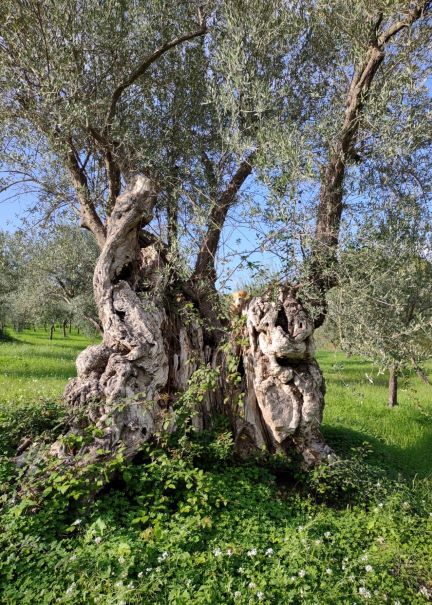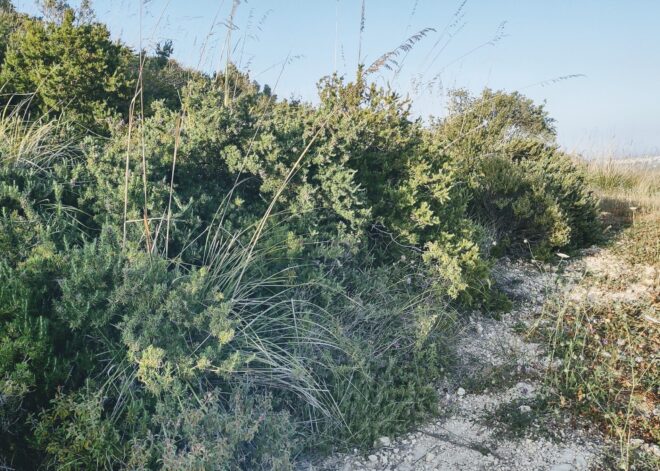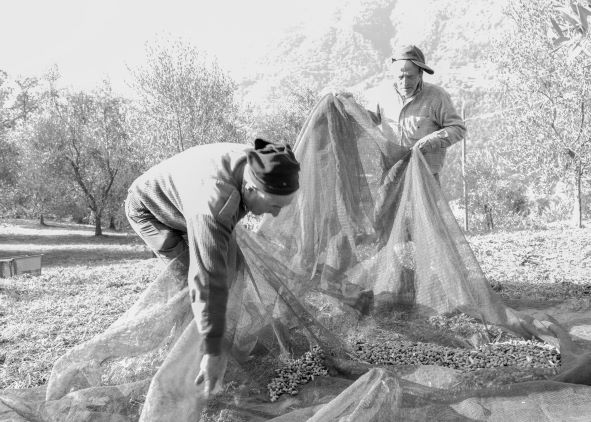
14 Fascinating facts about olive trees
“The olive tree is much more than merely a tree with a gnarled trunk; it is the emblematic embodiment of

If you take a walk in Sicily’s olive groves, specifically those smaller ones on the hillsides, you can find a lot of aromatic herbs. They grow along the edges, where the stone walls protect the fields against erosion and terraces formed in ancient days crumble. In fact, Sicily’s favorable climate, with plenty of sunshine, mild winters and fertile soil provide ideal conditions for the growth of various aromatic herbs, many of which can be found growing wild. Their presence in the wild allows for easy access and thus made them integral to Sicilian cuisine, adding distinctive flavours and aromas to traditional recipes. We are always curious to learn more about their usage in the Mediterranean cuisine, but also how to harvest and store the herbs. To share our gathered knowledge with you, we composed an overview of some herbs that we found in and around il circolo’s olive groves and that grow wild in Sicily.

Wild Fennel (Finocchietto selvatico) is abundant in Sicily. It is a perennial herb that can grow up to 2 meters (6.5 feet) tall. It has feathery, bright green leaves that resemble dill or fern. The plant produces clusters of small yellow flowers that later develop into aromatic seeds. The foliage and seeds of wild fennel have a strong anise-like aroma and flavor. The scent is sweet, licorice-like, and herbal. The seeds have a slightly nutty taste and can be used as a spice. You can find it growing along roadsides, fields, and hillsides. The foliage of wild fennel can be harvested throughout the growing season. It’s best to collect the leaves before the plant flowers to ensure the highest flavor. You can harvest the seeds when they turn brown and store them in airtight containers in a cool, dry place. You can use the fresh foliage in salads, soups, stews, and as a seasoning for various dishes. The seeds you can add as a spice in baking, sausage making, and pickling. In Sicilian cuisine wild fennel is used in dishes like pasta con le sarde (pasta with sardines), spaghetti with fennel and salami, or traditional dishes like chicken with olives, fennel and capers.
Oregano (Origano) grows naturally and thrives in sunny locations and well-drained soil. It is a perennial herb with small, oval-shaped leaves. The leaves are typically dark green and have a slightly hairy texture. The plant grows in bushy clusters and can reach a height of about 30 to 60 centimeters (12 to 24 inches). It is a hardy herb that can tolerate dry conditions. You can find it growing in rocky or sandy soil. Oregano leaves can be dried for later use. To dry oregano, harvest the sprigs before the plant flowers and hang them in a warm, dry, and well-ventilated area. Once dried, strip the leaves from the stems and store them in airtight containers in a cool, dark place. Oregano has an intense aroma and flavour and is a staple herb in the Italian cuisine, used in dishes like pizza, pasta sauces, marinades, salads, and roasted vegetables. It pairs well with other herbs like basil, thyme, and rosemary. Oregano can be used fresh or dried, with the dried form being more concentrated in flavor. The Sicilian cuisine uses oregano in many meat and fish preparations, but also in various antipasti, e.g. feta in the oven, and pasta dishes.
Thyme (Timo) is a perennial herb that belongs to the mint family, Lamiaceae. It is native to the Mediterranean region and is widely cultivated for its aromatic leaves and culinary uses. Thyme has a long history of medicinal and culinary applications. It is a herb that grows wild in the Mediterranean region, including Sicily, on hillsides, rocky slopes, and open woodlands. Thyme is a small, woody shrub with tiny leaves. The leaves are typically green-gray in color and have a slightly fuzzy texture. Thyme plants grow low to the ground and can form dense mats or small mounds. Thyme leaves can be harvested throughout the growing season. For the best flavor, harvest the leaves just before the plant flowers. The leaves can be used fresh or dried. To dry thyme, hang the sprigs upside down in a warm, well-ventilated area until they are completely dry. Once dried, store the leaves in airtight containers in a cool, dark place. Thyme has a distinctive flavour characterized by a combination of earthiness, warmth, and a subtle hint of mint. The flavour and aroma of thyme are concentrated in its leaves. Thyme is a versatile herb used in various cuisines worldwide. It is a key ingredient in Mediterranean, Italian, French, and Middle Eastern dishes. Thyme adds depth and complexity to soups, stews, sauces, roasted meats, vegetables, and marinades. It pairs well with other herbs like rosemary, oregano, and sage, as for example in a recipe for herb-crusted salmon. In Sicily it is traditionally used in dishes like roasted meats, stews, and marinades.
Rosemary (Rosmarino) is a perennial shrub with needle-like, narrow leaves that are dark green on top and lighter underneath and thrives well in the Sicilian climate.. The leaves are arranged in opposite pairs and have a resinous texture. The plant can grow up to 1 to 2 meters (3 to 6 feet) in height and has small, pale blue or lavender flowers. Rosemary has a robust, pine-like flavor with a slightly bitter and peppery taste. Rosemary leaves can be harvested throughout the year. For the best flavour, harvest the leaves in the morning after the dew has dried but before the sun becomes too hot. The leaves can be used fresh or dried. To dry rosemary, bundle the sprigs and hang them upside down in a warm, well-ventilated area. Once dried, store the leaves in airtight containers in a cool, dark place. Rosemary is a popular culinary herb used in Mediterranean and Italian cuisine. You can use its leaves to flavor a variety of dishes, including roasted meats, poultry, vegetables, soups, stews, bread, and sauces. Rosemary pairs well with other herbs like thyme, oregano, and sage, and adds a distinctive and aromatic flavor to recipes, such as, for example, fried polenta with mixed mushrooms.
Sage (Salvia) is a perennial herb with soft, gray-green leaves that are slightly fuzzy to the touch. The leaves are elongated and have an oval or lanceolate shape. Sage plants can grow up to about 60 centimeters (24 inches) in height and produce small, tubular flowers in various colors, including purple, blue, pink, or white. Sage grows wild in Sicily and can be harvested as needed throughout the growing season. For the best flavour, harvest the leaves before the plant flowers. The leaves can be used fresh or dried. To dry sage, bundle the sprigs and hang them upside down in a warm, well-ventilated area. Once dried, store the leaves in airtight containers in a cool, dark place. Sage has a strong, distinct flavor with hints of earthiness and a slightly bitter, peppery taste. Sage leaves can be used fresh or dried. It is fantastic in stuffing, as well as to flavour roasted meats, poultry, sausages, stuffing, sauces, and pasta dishes. It pairs well with ingredients like garlic, lemon, thyme, rosemary and butter. Have a look at our recipe for pumpkin soup with rosemary and fried sage.
Marjoram (Maggiorana), is a small perennial herb with oval-shaped leaves that are grayish-green in color. The leaves are soft and have a fuzzy texture. The plant grows in small, bushy clusters and can reach a height of about 30 to 60 centimeters (12 to 24 inches). Marjoram produces small white or pink flowers. It has a mild and sweet flavour with hints of citrus and pine. Marjoram’s flavour profile is more subtle compared to its close relative, oregano. You can harvest marjoram leaves as needed throughout the growing season. For the best flavor, harvest the leaves just before the plant flowers. You can use the leaves fresh or dried. To dry marjoram, bundle the sprigs and hang them upside down in a warm, well-ventilated area. Once dried, store the leaves in airtight containers in a cool, dark place. Marjoram is widely used in Mediterranean, Italian, and French cuisines. It is a versatile herb that complements a variety of dishes, including soups, stews, sauces, roasted vegetables, meat and fish dishes, and salads. Marjoram pairs well with other herbs like thyme, basil, and parsley. It is often added near the end of cooking to preserve its delicate flavor.
Mint (Menta) is a herbaceous perennial with square-shaped stems and opposite leaves that grows in Sicily in damp or shaded areas. The leaves are typically oval or lance-shaped, and their color can range from dark green to variegated. Mint plants can grow up to 30-90 centimeters (12-36 inches) tall, depending on the variety. Mint leaves can be harvested throughout the growing season. For the best flavor, harvest the leaves before the plant flowers. To harvest, simply pinch off the individual leaves or cut the stems above a leaf node. Mint leaves can be used fresh or dried. To dry mint, hang the stems upside down in a warm, well-ventilated area. Once dry, store the leaves in airtight containers away from light and moisture. Mint has a distinctively cool and refreshing flavour. It carries a refreshing, slightly sweet taste with hints of menthol. The aroma of mint is fresh, invigorating, and often associated with a sense of cleanliness. Mint is widely used in both sweet and savory culinary preparations. It is a key ingredient in beverages like mint tea, mojitos, and mint lemonade. Mint leaves are also used in salads, dressings, marinades, sauces, and desserts such as ice creams and chocolates. In the Sicilian cuisine mint is often used with fresh or grilled vegetables. It pairs well with ingredients like lemon, lime, cucumber, and lamb.
In addition to the more commonly known herbs, Sicily is home to several lesser-known wild herbs that grow in the region. These herbs may not be as widely used or recognized but they add diversity to the local flora and provide opportunities for exploring unique flavors and culinary experiences.

Purslane (Portulaca oleracea) grows wild in Sicily. It has succulent-like leaves that are smooth, thick, and paddle-shaped. The leaves are typically glossy and can range in color from green to reddish-green. The plant itself has a prostrate growth habit, with trailing stems that can spread horizontally along the ground. Purslane also produces small yellow flowers. Its tender leaves have a slightly tangy flavor. It is delicious in salads, soups, and stews. Purslane is rich in nutrients and known for its medicinal properties. It has a crisp texture and a slightly tangy, lemony flavor. Purslane can be eaten raw in salads, added to sandwiches, or used as a garnish. It is also commonly used in stir-fries, soups, stews, and sautés. In some cultures, it is pickled or used in traditional dishes. Purslane is highly nutritious and is a good source of vitamins, minerals, and omega-3 fatty acids. It contains high levels of vitamin C, vitamin A, and folate, as well as minerals like potassium, magnesium, and calcium. Purslane is also rich in antioxidants and is considered one of the richest vegetable sources of omega-3 fatty acids. Purslane leaves and stems can be harvested throughout the growing season. The leaves are typically plucked or cut close to the base of the plant. Purslane is best used fresh, as it does not store well and tends to wilt quickly. To extend its shelf life, you can store purslane in the refrigerator in a plastic bag with some moisture to help maintain its crispness.
Wild Mint (Mentha suaveolens) has a similar appearance to other mint species, with square stems and opposite leaves. The leaves are typically lance-shaped or elliptical, and they have a slightly fuzzy texture. The plant grows upright and can reach a height of about 30 to 60 centimeters (12 to 24 inches). Wild mint produces small clusters of flowers that are usually pale purple or white. Sicily is home to various wild mint varieties. These wild mints have a slightly different flavor profile compared to cultivated mint and grow in different parts of the island. You can use them in similar ways to cultivated mint, such as in beverages, teas, and culinary preparations.
Wild sorrel (Rumex acetosa) is a perennial herbaceous plant that is native to Europe and parts of Asia. Wild sorrel has slender, upright stems that can grow up to 60 centimeters (24 inches) in height. The leaves are arrow-shaped or elongated with distinctive deep lobes. They have a bright green color and a tangy, sour taste. The plant produces small, greenish-red flowers that form clusters on tall, branching stems. Wild sorrel has a distinctively tart, sour flavour, which is due to the presence of oxalic acid. The taste is often described as lemony or tangy. The leaves have a refreshing, acidic aroma. Wild sorrel is widely used in culinary preparations, particularly in European cuisine. Its tart flavor makes it a popular ingredient in salads, soups, sauces, and side dishes. You can use the leaves in as a garnish or added to omelets, quiches, and savory tarts to add a tangy kick. Wild sorrel pairs well with fish, poultry, and dairy products. Wild sorrel is rich in vitamins, minerals, and antioxidants. It contains vitamin C, vitamin A, vitamin K, and several B vitamins. Wild sorrel is also a good source of potassium, magnesium, and iron. However, it’s worth noting that wild sorrel contains oxalic acid, which can interfere with calcium absorption and may be a concern for individuals with certain health conditions.
Borage (Borago officinalis) is a herbaceous plant that grows up to 60-100 centimeters (24-40 inches) in height. It has hairy, branching stems and large, rough, oval-shaped leaves that are dark green in color. Borage produces beautiful star-shaped flowers that are typically blue in color, although pink and white varieties also exist. The leaves and flowers have a mild cucumber-like flavour, perfect for salads, soups, and herbal teas. The flowers are popular as a garnish for drinks and desserts, freezing them in ice cubes or crystallizing them for cake decorations. Borage leaves can be cooked and used as a spinach substitute or added to dishes like risotto or pasta.
Wild Rocket (Diplotaxis), also known as arugula or rucola, grows in Sicily’s coastal areas and wild landscapes. Wild rocket plants typically have elongated, deeply lobed leaves that are dark green in color. The leaves may vary in shape, with some varieties having more serrated or toothed edges. The plants can grow to a height of about 30 to 60 centimeters (12 to 24 inches), and they may produce small white or yellow flowers. Wild rocket leaves have a peppery, spicy taste that is slightly more intense than the flavor of cultivated arugula. They also possess a subtle bitterness. Its peppery bite adds a zesty kick to various dishes. Wild rocket can be mixed with other salad greens, used as a topping for pizzas, or incorporated into sandwiches and wraps. Harvesting is typically done by cutting the outer leaves from the plant, allowing the inner leaves to continue growing. To store wild rocket, rinse the leaves and pat them dry before placing them in a perforated plastic bag or wrapping them in a damp paper towel. Store the leaves in the refrigerator, where they can remain fresh for a few days.
Wild Oregano (Origanum vulgare) is a bushy herb that typically reaches a height of about 40-80 centimeters (16-31 inches). It has square-shaped stems and small, oval-shaped leaves that are gray-green in color. The leaves are covered in fine hairs, giving them a slightly fuzzy texture. In the summer, wild oregano produces clusters of small pink to purple flowers. Wild oregano has a strong and aromatic flavour with warm, slightly bitter undertones. Its taste is similar to cultivated oregano but is generally more pungent and robust. The aroma of wild oregano is intense and fragrant, characterized by a combination of spice, earthiness, and herbal notes. Wild oregano is a popular herb in the Sicilian cuisines. It is particularly well-known for its presence in tomato-based sauces, pizza, pasta, roasted vegetables, and grilled meats. Wild oregano can be added at various stages of cooking to infuse dishes with its aromatic essence.
All these herbs are wonderful complements to various Mediterranean dishes and go perfectly well with our fresh extra virgin olive oil!

“The olive tree is much more than merely a tree with a gnarled trunk; it is the emblematic embodiment of

As of the end of 2020 il circolo is allowed to use the D.O.P. label for its extra virgin olive

Il circolo stands (among other things) for the annual rings of our centuries-old olive trees growing on the slopes of

il circolo V.O.F.
Tacituslaan 7
3584AP Utrecht
Netherlands
[email protected]
tel: +31 (0)6 42254141
KvK/HRB: 74704257
BTW/MwSt: NL859998502B01
5 euro discount on your next purchase?
Sign up for our newsletter with tasty recipes and interesting background stories about il circolo olive oil and receive a discount code for yourself and your friends (displayed after email confirmation).
This website uses cookies so that we can provide you with the best user experience possible. Cookie information is stored in your browser and performs functions such as recognising you when you return to our website and helping our team to understand which sections of the website you find most interesting and useful.
Strictly Necessary Cookie should be enabled at all times so that we can save your preferences for cookie settings.
If you disable this cookie, we will not be able to save your preferences. This means that every time you visit this website you will need to enable or disable cookies again.